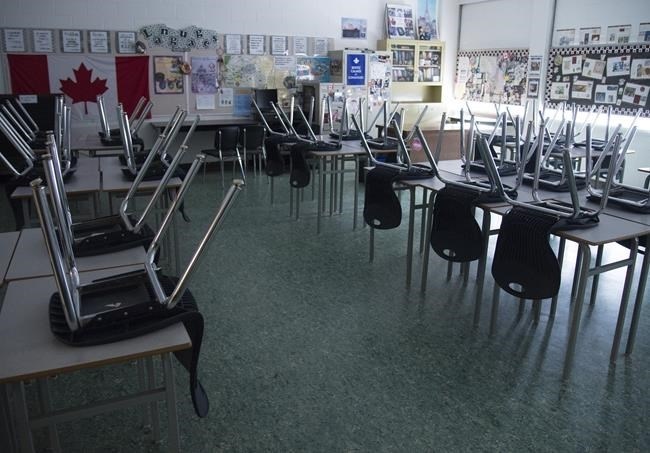
FILE. An empty classroom.
Image Credit: THE CANADIAN PRESS/Jonathan Hayward
December 08, 2020 - 7:30 AM
Staffing shortages at Central Okanagan schools are standard this time of year as flu and colds spread through classrooms, but these seasonal sick days are a bit more pronounced with the pandemic.
So much so the school district’s superintendent was at the front of a class last week.
“Experiencing occasional teachers teaching on call shortages at this time of year happens every year,” Kevin Kaardal, superintendent of Central Okanagan Public Schools said. “It has been exacerbated by about 15 or 20 per cent on some days due to COVID 19 related absences.”
These absences include the isolation of staff who are not symptomatic but were a close contact with a positive exposure.
There are currently 14 schools in the Central Okanagan school district that are reporting a COVID-19 exposure — more than any district in Interior Health and a reflection of the fact the pandemic has left a bigger mark on this more populous area than other areas within the health authority.
Kaardal said the number of teachers away isn’t even the entire issue.
“There are days that we are short the number of teachers teaching on call who is available or willing to work to cover absences,” he said.
When this happens, the administration typically reassigns teachers, asking them to teach during their prep time, have principals or vice-principals cover, or reassign non-enrolling or itinerant teachers who support students in different ways to cover the shortage of available subs.
“They do the lion's share of extra coverage,” he said.
Anticipating increased anxiety, rising COVID-19 numbers and cold and flu season, the senior team at the district made a decision that they would share the burden of coverage so that more teachers could keep their preparation periods, and non-enrolling teachers and itinerant teachers could continue to offer those important services to students.
On Friday, Dec. 4, when Kaardal stepped into the classroom, other senior leaders were covering absences as well.
“In my case, we could have reassigned a teacher but chose not to,” he said. “It is also good to be in schools (on the dance floor) getting an even closer snapshot about how our plans are working. It is invigorating. It reminds us of the importance of what we are trying to accomplish.”
When he got back into the swing of things Friday, Kaardal said a UBC Okanagan student teacher was delivering her last lesson in the class he was covering.
“I just supported her and helped the students with questions … so pretty light duty,” he said. “I didn't know this was the case when I arrived to support the school or began reading the teacher's lesson in preparation for the class. When she arrived I was happy to see her. If all of our teacher-candidates are as professional – the future of the system is in good hands.”
Kaardal’s run in the teacher’s seat was well known by the weekend and he said it’s not as big of a deal as it was made out to be. Usually, he’s in classes every couple of weeks viewing or participating in lessons.
Within Interior Health, if a student or teacher receives a confirmed positive COVID-19 test result, the health authority starts contact tracing to determine how the person was infected and who they were in close contact with. They then identify and notify close contacts who may be at an increased risk, and advise them to self isolate and monitor for symptoms for 14 days, informing the schools as they go.
IH public health determines close contacts of individuals who have tested positive for COVID-19 using specific criteria, based on the likelihood of transmission.
This has been the process across the province until recently, when parents in the Fraser Valley, much like parents in the Interior, expressed concern about the lack of information shared. For example, parents have said that multiple exposure dates have appeared without notice to schools or parents. Or, in other cases, exposure notices came in long after the two-week containment period, causing further confusion.
As such, Fraser Health indicated this weekend it's shifting its plans. Now there will be three letters to parents, like early notification exposed and early notification not exposed. The latter will explain there was an exposure in a school, but it wasn’t in your cohort.
There will also be an early notification for when a case is not attached to a specific class.
To contact a reporter for this story, email Kathy Michaels or call 250-718-0428 or email the editor. You can also submit photos, videos or news tips to the newsroom and be entered to win a monthly prize draw.
We welcome your comments and opinions on our stories but play nice. We won't censor or delete comments unless they contain off-topic statements or links, unnecessary vulgarity, false facts, spam or obviously fake profiles. If you have any concerns about what you see in comments, email the editor in the link above.
News from © iNFOnews, 2020